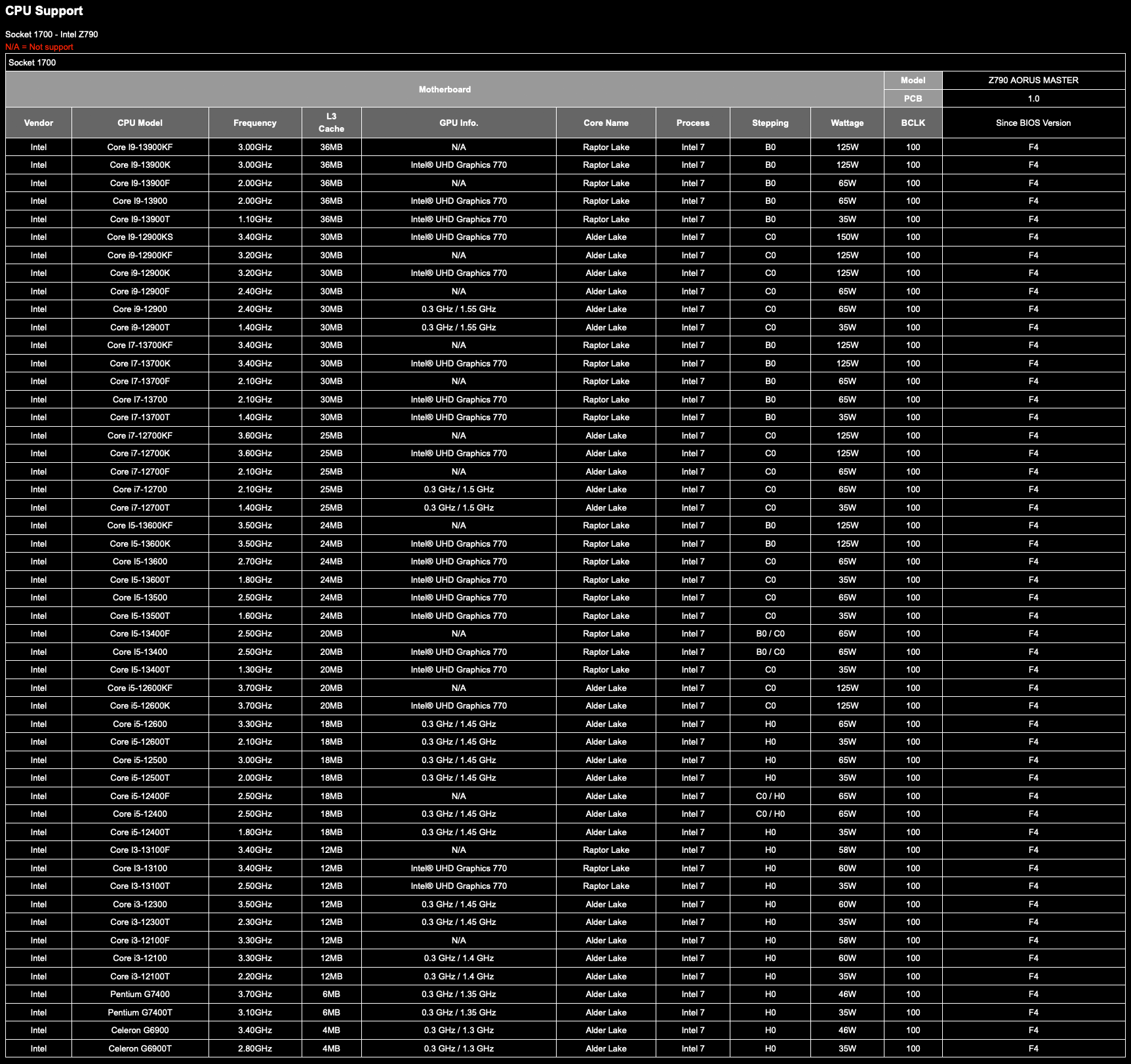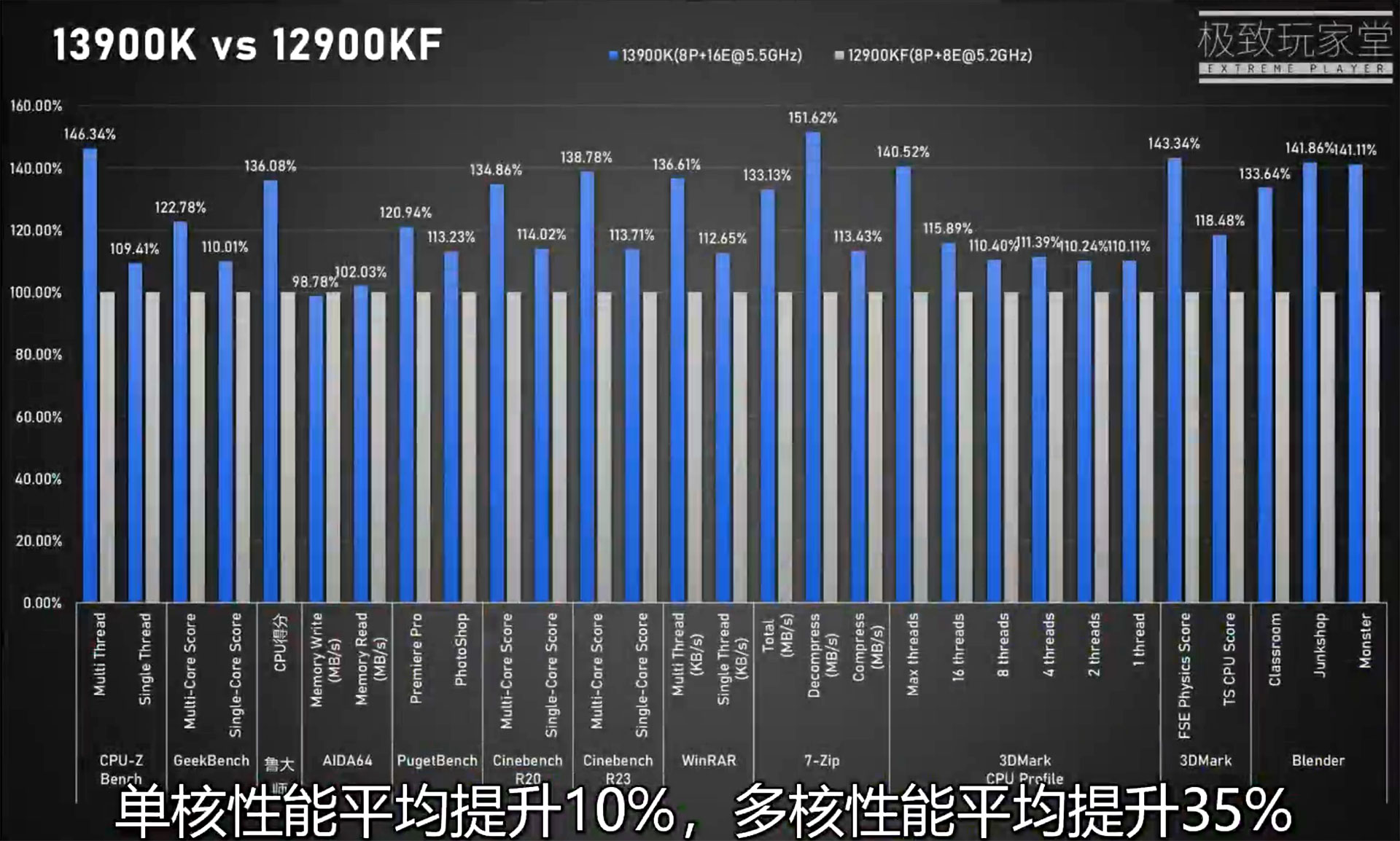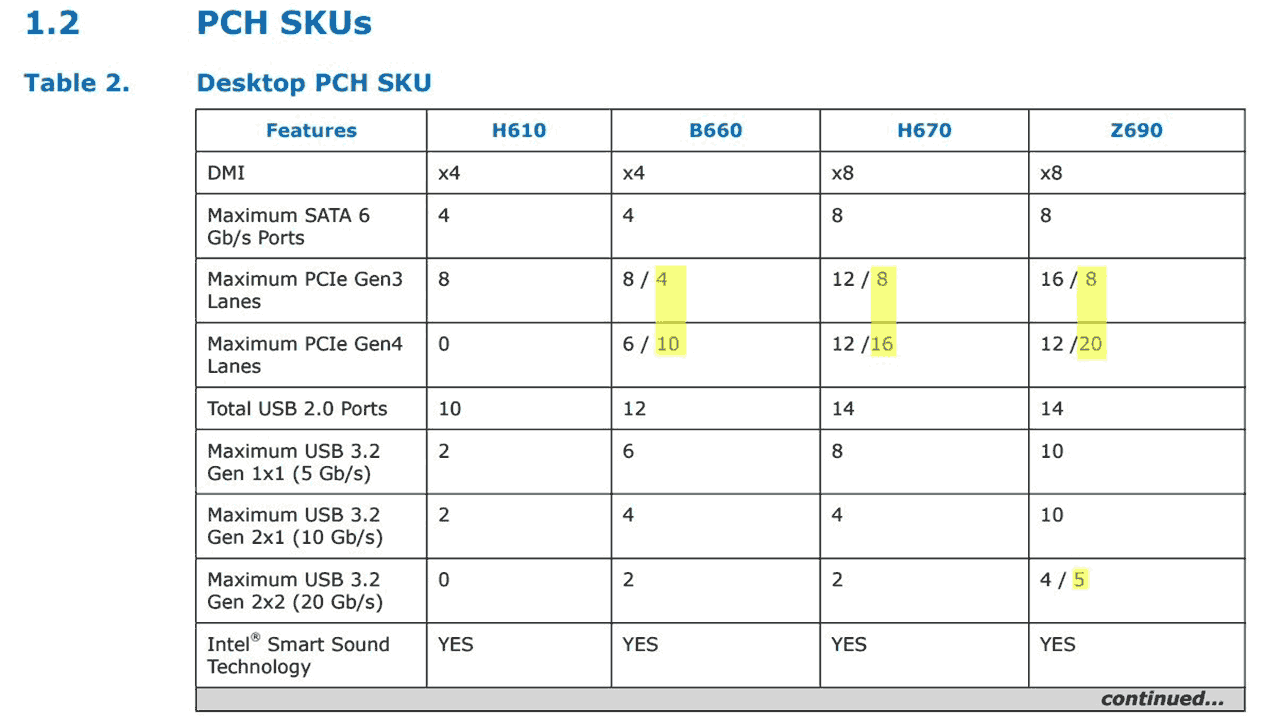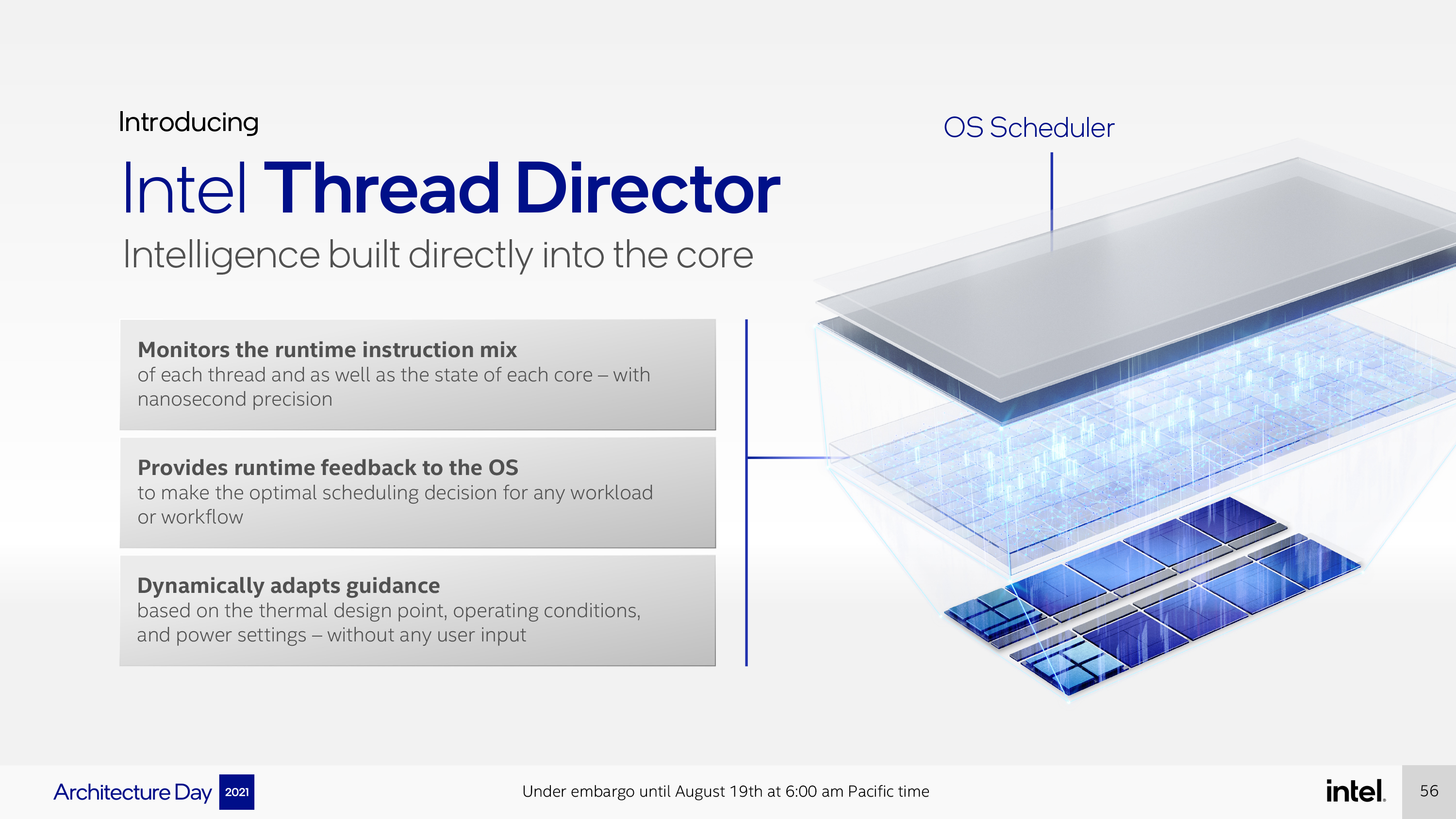Intel 13th-Gen Raptor Lake Specs, Release Date, Benchmarks, and More
More cores, cache, and higher frequencies
- Intel 13th-Gen Raptor Lake Series at a Glance
- Intel 13th-Gen Raptor Lake Release Date Window
- Intel 13th-Gen Raptor Lake Specifications and Features
- Raptor Lake vs Ryzen 7000
- Intel 13th-Gen Raptor Lake Die Pictures
- Intel 13th-Gen Raptor Lake Benchmarks and IPC
- Intel 13th-Gen Raptor Lake Architecture
- Intel 13th-Gen Raptor Lake 700-Series Motherboards
- Intel Thread Director
- Intel 13th-Gen Raptor Lake Pricing

UPDATE: Our review of the Raptor Lake Core i9-13900K, Core i7-13700K, and Core i5-13600K is live now at this link: Intel Core i9-13900K and Core i5-13600K Review: Raptor Lake Beats Ryzen 7000,
Original article:
Intel's 13th-Gen Raptor Lake processors will bring more cores, more connectivity, a revamped core architecture, support for PCIe 5.0 SSDs, and even an officialy-verified 6.0 GHz peak boost clock to bear. Intel claims that Raptor Lake will have a 15% gain in single-threaded performance and a 41% gain in multi-threaded compared to Alder Lake, and an overall '40% performance scaling.' These chips will arrive on October 20 to square off with AMD's Zen 4 Ryzen 7000 processors, setting the stage for a fierce battle for desktop PC supremacy — particularly for the crown of the best CPU for gaming as the Intel vs AMD rivalry enters a new stage.
Intel's Alder Lake brought the company back from what had been a slow erosion of its leadership position in our CPU benchmarks rankings as AMD relentlessly iterated on its Ryzen processor lineup. AMD's string of innovations eventually culminated in an embarrassing loss of the performance crown for Intel as the Ryzen 5000 processors outclassed Intel's chips in every performance, price, and power metric that mattered back in 2020, capping Intel's decline from grace after incessant delays moving to its oft-delayed and seemingly doomed 10nm process node.
Alder Lake righted the ship. These chips brought the best of Intel's newly re-worked 10nm process, now re-named 'Intel 7,' enabling higher clock rates and lower power consumption, paving the way for Raptor Lake. Intel will etch the Raptor Lake processors on a refined version of that same process node and pair it with its newly-revamped x86 hybrid architecture, a design that combines a mix of larger high-performance cores paired with smaller high-efficiency cores.
| Row 0 - Cell 0 | Price | Cores / Threads (P+E) | P-Core Base / Boost Clock (GHz) | E-Core Base / Boost Clock (GHz) | Cache (L2/L3) | TDP / PBP / MTP | Memory |
| Core i9-13900K / KF | $589 (K) - $564 (KF) | 24 / 32 (8+16) | 3.0 / 5.8 | 2.2 / 4.3 | 68MB (32+36) | 125W / 253W | DDR4-3200 / DDR5-5600 |
| Core i7-13700K / KF | $409 (K) - $384 (KF) | 16 / 24 (8+8) | 3.4 / 5.4 | 2.5 / 4.2 | 54MB (24+30) | 125W / 253W | DDR4-3200 / DDR5-5600 |
| Core i5-13600K / KF | $319 (K) - $294 (KF) | 14 / 20 (6+8) | 3.5 / 5.1 | 2.6 / 3.9 | 44MB (20+24) | 125W / 181W | DDR4-3200 / DDR5-5600 |
Like its predecessor, Raptor Lake will also support disruptive new features like PCIe 5.0 and DDR5 but preserves DDR4 support for less-expensive build options. Raptor Lake will also drop into existing motherboards to offer an upgrade path for Alder Lake users, but there will be new 700-series motherboards at launch that offer better connectivity options. Intel is also introducing more CPU overclock features for Raptor Lake, too.
Intel has finally given us a broad overview of what to expect, including specs and pricing, and we even managed to track down an unannounced 34-core model at an Intel trade show. We've gathered all of the information we know from official and unofficial sources into this article. We'll update the article as we learn more, but here's what we know so far.
Intel 13th-Gen Raptor Lake Series at a Glance
- Codename Raptor Lake
- Desktop and mobile launch in Q4 2022 (October 20)
- Up to 24 cores and 32 threads on 'Intel 7' process node (34-core spotted)
- Up to 8 Raptor Cove Performance cores (P-Cores) and 16 Gracemont Efficiency cores (E-Cores)
- Raptor Lake-S (65W to 125W desktop) and Raptor Lake-P (15 to 45W mobile) confirmed
- Up to 6 GHz boost
- Up to 36MB of L3 Cache (20% increase), up to 32MB L2 (2.3x increase)
- Dual-Channel DDR4-3200 and DDR5-5600 memory support, x16 PCIe 5.0 and x4 PCIe 4.0 interface, Thunderbolt 4 / USB 4
- Support for PCIe 5.0 M.2 SSDs and AI M.2 Module
- +15% single-threaded performance, +41% gain in multi-threaded, overall '40% performance scaling.'
- Socket LGA 1700, backward compatible with existing coolers, mobile chips are BGA compatible
- 700-Series Chipset: Z790, H770, B760 Motherboards
- Chipset: Up to 20 PCH PCIe 4.0 and eight PCIe 3.0
- Enhanced CPU overclocking features, including per-core and Efficient Thermal Velocity Boost
Intel 13th-Gen Raptor Lake Release Date Window
Intel will launch the 13th-Gen Raptor Lake processors on October 20. Intel has also announced that it will bring the Raptor Lake mobile CPUs to market this year, too.
Preorders will purportedly begin on October 13, and retail availability for the K-series SKUs will arrive on October 20 along with the Z790 motherboards. Non-K CPUs and the B760 and H760 chipsets reportedly won't be announced until January 5, 2023, at CES, with retail availability in the second half of that month. Some Intel 13th-Gen Raptor Lake silicon is also shipping early from retailers, probably by mistake.
Get Tom's Hardware's best news and in-depth reviews, straight to your inbox.
Intel is also accelerating its mobile launch, with CEO Pat Gelsinger recently announcing that the mobile platforms will launch this year. We've even seen benchmarks emerge from the mobile Raptor Lake processors.
Intel 13th-Gen Raptor Lake Specifications and Features
Intel recently disclosed that its top-end Raptor Lake processors will reach up to 6 GHz at stock settings and have set a world overclocking record at 8GHz - obviously with liquid nitrogen. World record overclocker Allen 'Splave' Golibersuch also recently pushed a Core i9-13900K to 8.2 GHz with Liquid Nitrogen (LN2), beating AMD's peak overclocking frequency with the Ryzen 7000 chips.
Notably, the peak of 6 GHz is 300 MHz faster than the 5.7 GHz for AMD's Ryzen 7000 processors, but Intel hasn't announced which product will hit that peak speed. We also aren't sure if a 6GHz chip will arrive with the first wave of chips or be a special edition 'KS' model.
Intel's official listing of features touts up to 24 cores and 32 threads with the Core i9-13900K, 16 cores and 24 threads with the i7-13700K, and 14 cores and 20 threads with the Core i5-13600K.
The Raptor Lake chips are fabbed on the 'Intel 7' process and will have a 15% gain in single-threaded performance and a 41% gain in multi-threaded compared to Alder Lake, and an overall '40% performance scaling.' Raptor Lake also comes with enhanced overclocking features, support for an AI M.2 module, and the chips are compatible with Alder Lake systems.
The 13th-Gen Raptor Lake chips will have Performance Cores (P-cores) with a new Raptor Cove microarchitecture. These cores are designed for single- and lightly-threaded tasks, like gaming and productivity workloads. The Efficiency Cores (E-cores) also bear signs of a revamped microarchitecture, like a doubled L2 cache, but these cores still have the Gracemont design. These cores step in for heavily-threaded workloads, background tasks, and multitasking.
| Row 0 - Cell 0 | Price | Cores / Threads (P+E) | P-Core Base / Boost Clock (GHz) | E-Core Base / Boost Clock (GHz) | Cache (L2/L3) | TDP / PBP / MTP | Memory |
| Core i9-13900K / KF | $589 (K) - $564 (KF) | 24 / 32 (8+16) | 3.0 / 5.8 | 2.2 / 4.3 | 68MB (32+36) | 125W / 253W | DDR4-3200 / DDR5-5600 |
| Ryzen 9 7950X | $699 | 16 / 32 | 4.5 / 5.7 | - | 80MB (16+64) | 170W / 230W | DDR5-5200 |
| Core i9-12900K / KF | $589 (K) - $564 (KF) | 16 / 24 (8+8) | 3.2 / 5.2 | 2.4 / 3.9 | 44MB (14+30) | 125W / 241W | DDR4-3200 / DDR5-4800 |
| Ryzen 9 7900X | $549 | 12 / 24 | 4.7 / 5.6 | - | 76MB (12+64) | 170W / 230W | DDR5-5200 |
| Core i7-13700K / KF | $409 (K) - $384 (KF) | 16 / 24 (8+8) | 3.4 / 5.4 | 2.5 / 4.2 | 54MB (24+30) | 125W / 253W | DDR4-3200 / DDR5-5600 |
| Core i7-12700K / KF | $409 (K) - $384 (KF) | 12 / 20 (8+4) | 3.6 / 5.0 | 2.7 / 3.8 | 37MB (12+25) | 125W / 190W | DDR4-3200 / DDR5-4800 |
| Ryzen 7 7700X | $399 | 8 / 16 | 4.5 / 5.4 | - | 40MB (8+32) | 105W / 142W | DDR5-5200 |
| Ryzen 5 7600X | $299 | 6 / 12 | 4.7 / 5.3 | - | 38MB (6+32) | 105W / 142W | DDR5-5200 |
| Core i5-13600K / KF | $319 (K) - $294 (KF) | 14 / 20 (6+8) | 3.5 / 5.1 | 2.6 / 3.9 | 44MB (20+24) | 125W / 181W | DDR4-3200 / DDR5-5600 |
| Core i5-12600K / KF | $289 (K) - $264 (KF) | 10 / 16 (6+4) | 3.7 / 4.9 | 2.8 / 3.6 | 29.5MB (9.5+20) | 125W / 150W | DDR4-3200 / DDR5-4800 |
| Core i5-13400 / F | ? | 10 / 16 (6+4) | 3.4 / ? | ? | 24MB | 65W / ? | DDR4-3200 / DDR5-5600 |
| Core i5-12400 / F | $199 - $167 (F) | 6 / 12 (4+0) | 4.4 / 2.5 | - | 25.5MB (7.5+18) | 65W / 117W | DDR4-3200 / DDR5-4800 |
Above, we can see the Core i9, i7, and i5 flagships from Intel's previous-gen family, along with what we know about the new Raptor Lake models. Intel is releasing three K-series models to start along with their graphics-less KF counterparts, with the more expansive launch coming early next year.
Intel will purportedly only release Core i9, i7, and some i5 models with the Raptor Lake die, while some i5 and all i3, Pentium, and Celeron will leverage refreshed previous-gen Alder Lake chips (Intel took a similar approach with its 11th-Gen Rocket Lake processors).
The Core i9-13900K will come with a total of 24 cores representing a mix of eight P-cores and 16 E-cores. That's an additional eight E-cores over the previous-gen flagship (but the same number of P-cores). These additional E-cores come from a new larger 8+16 die (8 P-core + 16 E-core) that Intel will use for the Core i9, i7, and K-series i5 chips only. This larger die comes with additional cache capacity for the cores (more on that in the architecture section), but Core i3 and below will have the same amount of cache as found with the existing Alder Lake models.
The 24-core $589 Core i9-13900K will square off with AMD's 16-core $699 Ryzen 9 7950X, so Intel could have a pricing advantage if it can match or beat it.
The $409 Core i7-13700K also gets a 400 MHz p-core frequency bump to 5.4 GHz, four more e-cores for a total of eight, and a 400 MHz e-core boost to 4.2 GHz.
Surprisingly, Intel has increased the MTP for this chip to 253W, a 63W increase over the prior gen. The 13700K contends with the $399 Ryzen 7 7700X.
The 13600K receives four more e-cores than the prior-gen, 200 MHz higher p-core clocks to reach 5.1 GHz, and a 300 MHz e-core improvement yields a 3.9 GHz boost. The 13600K also has a 31W MTP increase to 181W, so Intel is raising power limits here, too.
While Intel has raised the peak frequencies for both p-cores and e-cores on all Raptor Lake chips, we see a 200 MHz decline in the base clocks. That shouldn't mean much in practical application and is probably done to manage the TDP rating. Speaking of which, the 13900K has the same 125W Base Turbo Power (BTP) as before, but the Maximum Turbo Power (MTP) has increased by 12W and is now 253W.
the $319 Core i3-13600K is the lone chip to receive a price increase; both the full-fledged model and the graphics-less 13600KF are $30 more expensive than the prior gen. This is by far the highest-volume SKU and slots into a pricing tier where AMD isn't as competitive, so Intel's increase here will generate the most cash while not threatening its strategy of undercutting AMD on the high end. However, AMD's $299 Ryzen 5 7600X is a potent gaming chip, so we'll have to see how the performance story plays out when Raptor Lake hits our bench table. The 13600K receives four more e-cores than the prior-gen, 200 MHz higher p-core clocks to reach 5.1 GHz, and a 300 MHz e-core improvement yields a 3.9 GHz boost. The 13600K also has a 31W MTP increase to 181W, so Intel is raising power limits here, too.
Some of the improvements apply to all three chips. For example, Intel increased the L2 cache from 1.25MB to 2MB for each p-core, and doubled the amount of L2 cache for each cluster of e-cores to 4MB. The amount of L3 cache has also increased due to adding more e-core clusters, each of which has an adjacent L3 cache slice as part of the design. That leads to cache capacity increases for all K-series Raptor Lake chips.
Intel has increased its DDR5 memory support up to 5600 MT/s if you use one DIMM per channel (1DPC), a big increase over the prior 4800 MT/s speed with Alder Lake. Just as importantly, Intel increased 2DPC speeds up to 4400 MT/s, an improvement over the previous-gen 3600 MT/s. Intel will also continue to support DDR4 memory, which it predicts will coexist in the market with DDR5 until the end of 2024. This approach ensures a value option for Intel platforms, unlike AMD's all-in approach with DDR5.
Intel has confirmed that the Alder Lake chips will drop into the LGA 1700 socket, meaning they are backward compatible with the existing 600-series chipsets, and older coolers are also forward compatible with the new Raptor Lake motherboards. In addition, the 16 PCIe 5.0 PCIe lanes coming off the CPU can now be split into dual x8 arrangements, thus enabling support for PCIe 5.0 M.2 SSDs. We'll dive much deeper into this topic in the motherboard section.
The Raptor Lake iGPU is said to be based on the same Xe-LP Gen 12.2 architecture found with Alder Lake. A recent benchmark emerged showing the Raptor Lake Core i9-13900's iGPU with 32 EUs running at 1.65 GHz in an OpenGL benchmark. That means the iGPU has the same number of cores but runs 100 MHz (6.5%) faster than the previous-gen version. Aside from minor clock speed improvements, we don't expect any meaningful architectural changes to the iGPU. Intel did recently add support for Raptor Lake-P (mobile) and Raptor Lake-S (desktop) processors to its media driver, thus tipping its hat that mobile variants of Raptor Lake are also in the works.
Intel has also teased a new AI accelerator that will slot into an M.2 slot. It's hard to tell what practical purpose this would serve for most uses, though some edge use-cases might benefit. Intel hasn't shared any more information about this product, and there hasn't been any other information, so we'll have to wait to learn more.
Intel 13th-Gen Raptor Lake E-core E-volution
It's clear that Intel has changed its Core i5 E-core strategy. The current K-series Core i5, the Core i5-12600K, comes with four E-cores, but the Core i5-13600K has four additional E-cores, for a total of eight. Traditionally, the rest of the non-K Core i5 models, like the Core i5-12400, don't have E-cores. Intel is said to be adding E-cores to the non-K Core i5 Raptor Lake chips, which could make its mid-range Core i5 all the more potent [Edit: as you can see below, this has proven to be true].
Intel says that even though the e-cores use the same Gracemont architecture, changes to the caching policy and a few other fine-grained optimizations (more below) now yield the same IPC and frequency as the original 14nm Skylake cores, but at lower power. Notably, the e-cores give Intel the core count lead on the mainstream desktop PC, as AMD's Ryzen tops out at 16 cores with the 7950X.
Above, we can see leaked Raptor Lake specs for the entire 13th-Generation Intel family. These were brought to us by none other than Gigabyte, so they are guaranteed to be accurate.
The die revisions are of particular note here. Thirteen of the 13th-Gen Intel processors use Raptor Lake B0 die, and two of the chips will use either B0 or the Alder Lake C0 chips. Finally, two other processors will use either Alder Lake C0 or H0 die.
This means the non-K Core i5 models have been revamped with e-cores, just like the i3 models. Intel has stated that it will bring e-cores further down the Core i5 stack, so this lines up with the above information.
| Model | Base Clock | L3 Cache | PBP | Silicon | Stepping |
| Core i9-13900K/KF | 3.0 GHz | 36 MB | 125W | RPL B0 | Raptor Lake |
| Core i9-13900/F | 2.0 GHz | 36 MB | 65W | RPL B0 | Raptor Lake |
| Core i9-13900T | 1.10 GHz | 36 MB | 35W | RPL B0 | Raptor Lake |
| Core i7-13700K/KF | 3.40 GHz | 30 MB | 125W | RPL B0 | Raptor Lake |
| Core i7-13700/F | 2.10 GHz | 30 MB | 65W | RPL B0 | Raptor Lake |
| Core i7-13700T | 1.40 GHz | 30 MB | 35W | RPL B0 | Raptor Lake |
| Core i5-13600K/KF | 3.50 GHz | 24 MB | 125W | RPL B0 | Raptor Lake |
| Core i5-13600 | 2.70 GHz | 24 MB | 65W | ADL C0 | Alder Lake |
| Core i5-13600T | 1.80 GHz | 24 MB | 35W | ADL C0 | Alder Lake |
| Core i5-13500 | 2.50 GHz | 24 MB | 65W | ADL C0 | Alder Lake |
| Core i5-13500T | 1.60 GHz | 24 MB | 35W | ADL C0 | Alder Lake |
| Core i5-13400/F | 2.50 GHz | 20 MB | 65W | RPL B0 | ADL C0 | Alder Lake | Raptor Lake |
| Core i5-13400T | 1.30 GHz | 20 MB | 35W | ADL C0 | Alder Lake |
| Core i3-13100/F | 3.40 GHz | 12 MB | 60W/58W | ADL H0 | Alder Lake |
| Core i3-13100T | 2.50 GHz | 12MB | 35W | ADL H0 | Alder Lake |
Here's a table with the basic specs from the Gigabyte listing. We have plenty of other architectural information to share in the sections below. But first, let's take a break to look at the leaked Raptor Lake benchmarks.
Intel 13th-Gen Raptor Lake vs AMD Zen 4 Ryzen 7000
| Row 0 - Cell 0 | AMD Zen 4 Ryzen 7000 | Intel Raptor Lake |
| Release Date | September 27th | October 20 |
| Node / Design | TSMC 5nm Compute die, 6nm I/O DIe | Intel 7 - Monolithic Die |
| Cores / Threads | Up to 16 Cores / 32 Threads | Up to 8P + 16E | 24 Cores / 32 Threads |
| Peak Clocks | 5.7 GHz | 6.0 GHz |
| TDP / PBP / MTP | 170W / 230W | 125W / 253W |
| Memory | DDR5 Only (No DDR4 support) | DDR4-3200 / DDR5-5600 |
| PCIe | PCIe 5.0 - 24 Lanes | PCIe 5.0 x16, PCIe 4.0 x4 (SSD) |
| Graphics | RDNA 2 iGPU | UHD Graphics 770 |
Here's what the Raptor Lake vs Ryzen 7000 competition will look like. Both chipmakers are pushing clocks to the highest we've seen with their modern chips, and that will naturally come with increased power consumption, particularly in multi-threaded work.
AMD's Zen 4 Ryzen 7000 chips only support DDR5 memory, while Raptor Lake supports DDR4 and DDR5. That gives Intel a leg up in the overall system cost category, as DDR5 still commands a price premium. However, we no longer see DDR5 shortages, and prices continue to plummet as more supply comes online and demand recedes. That means the pricing delta should get noticeably slimmer, though we fully expect DDR5 to always command a premium.
Intel 13th-Gen Raptor Lake Die Pictures
We've already seen plenty of 13th-gen Intel Raptor Lake benchmarks emerge (more about that below), so it's clear that plenty of Raptor Lake chips are floating around in the wild. Now we have pictures of the actual die, too.
A video posted to Bilibili shows the dimensions of the Raptor Lake die, which measures 23.8 x 10.8mm. That means the chips have a slightly wider and much longer die than the 12th-gen Alder Lake processors.
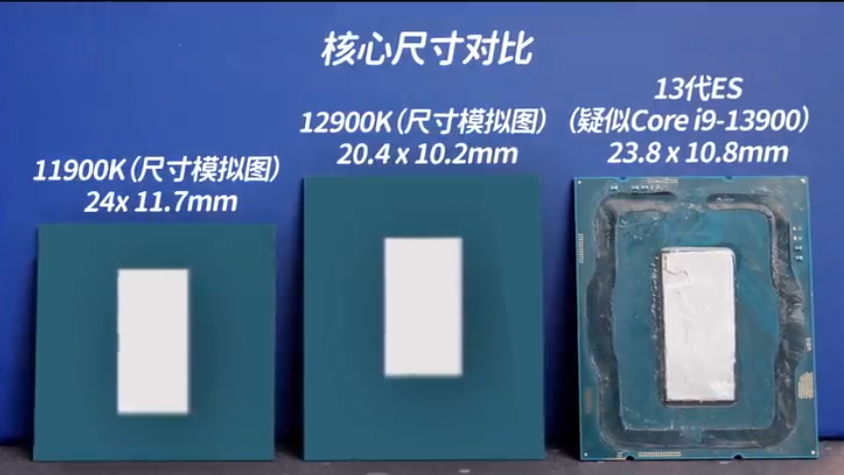
| Row 0 - Cell 0 | Die Area | Die Dimensions | Cores | Process |
| Raptor Lake Core i9-13900K | 257 mm^2 | 23.8 x 10.8 mm | 8 P-Cores | 16 E-Cores | Intel 7 |
| Alder Lake Core i9-12900K | 208 mm^2 | 20.4 x 10.2 mm | 8 P-Cores | 8 E-Cores | Intel 7 |
| Rocket Lake Core i9-11900K | 281 mm^2 | 24 x 11.7 mm | 8 P-Cores | 14nm |
| Comet Lake Core i9-10900K | 206 mm^2 | 9.2 x 22.4 mm | 10 P-Cores | 14nm |
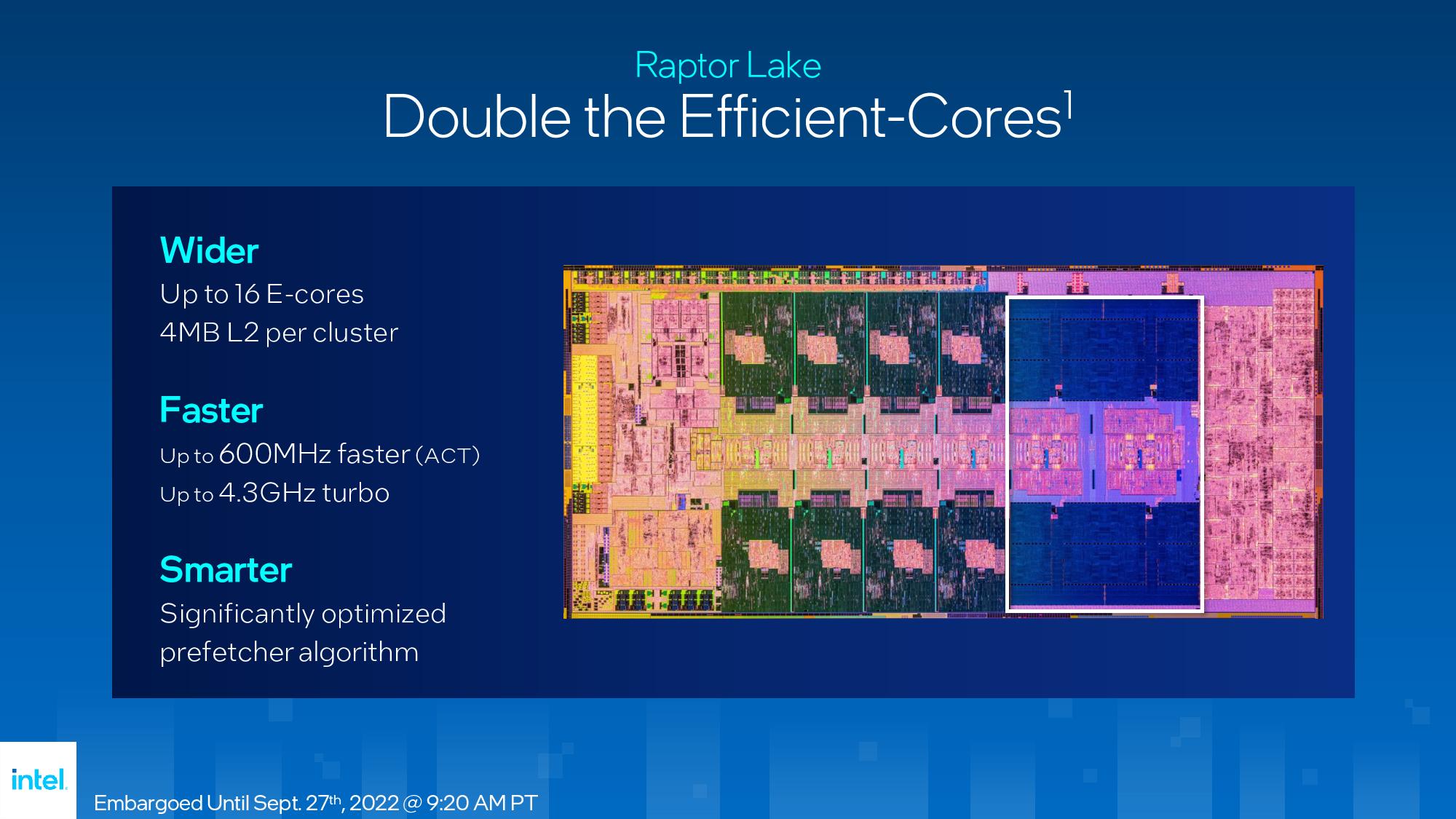

Here we can see the 11900K, 12900K, and Raptor Lake Core i9-13900K together. Intel increased the core count for Raptor Lake by moving from a peak of eight E-cores to 16 by adding two more quad-core clusters, increased the L2 cache by 60% overall (doubled e-cores to 4MB), and also increased the L3 cache capacity (more details below).
All of these factors necessitated an 8+16 die that is 49mm^2 larger than the previous-gen 8+8 die. Each E-core cluster weighs in at roughly ~8.65 mm^2, meaning only 17.3 mm^2 of the die increase is dedicated to the E-cores, while the rest is allocated to the larger L2 and L3 caches. That's a real testament to the incredibly area-efficient nature of the e-cores. However, the larger chip size amounts to more costly manufacturing because a larger die results in fewer dies per wafer.
Intel has improved the frequency of the e-cores up to 4.3 GHz on the 13900K, and it has also increased the all-core clock rates by 600 MHz.
Leveraging the faster memory speeds requires a faster fabric. Intel has increased the ring bus frequency to 5 GHz and it is 900 MHz faster during all-core turbo, addressing a glaring issue we saw with Alder Lake. Intel says the ring bus enhancements alone can result in 5% higher framerates (we've also seen solid increases from overclocking this setting on Alder Lake).
Good pic.twitter.com/UYNBG6nwfaAugust 4, 2022
Intel 13th-Gen Raptor Lake Benchmarks and IPC
Intel has provided a limited selection of its own benchmarks of the 13th-Gen CPUs, which we'll cover first, but as always with vendor-provided data, take it with a grain of salt. Luckily, we've also seen plenty of leaked benchmarks that give us a better idea of what Raptor Lake will look like. However, as with all leaked test results, take all of the benchmarks below with a grain of salt — they are often conducted with pre-production silicon and unoptimized platforms, meaning final results could be materially better.
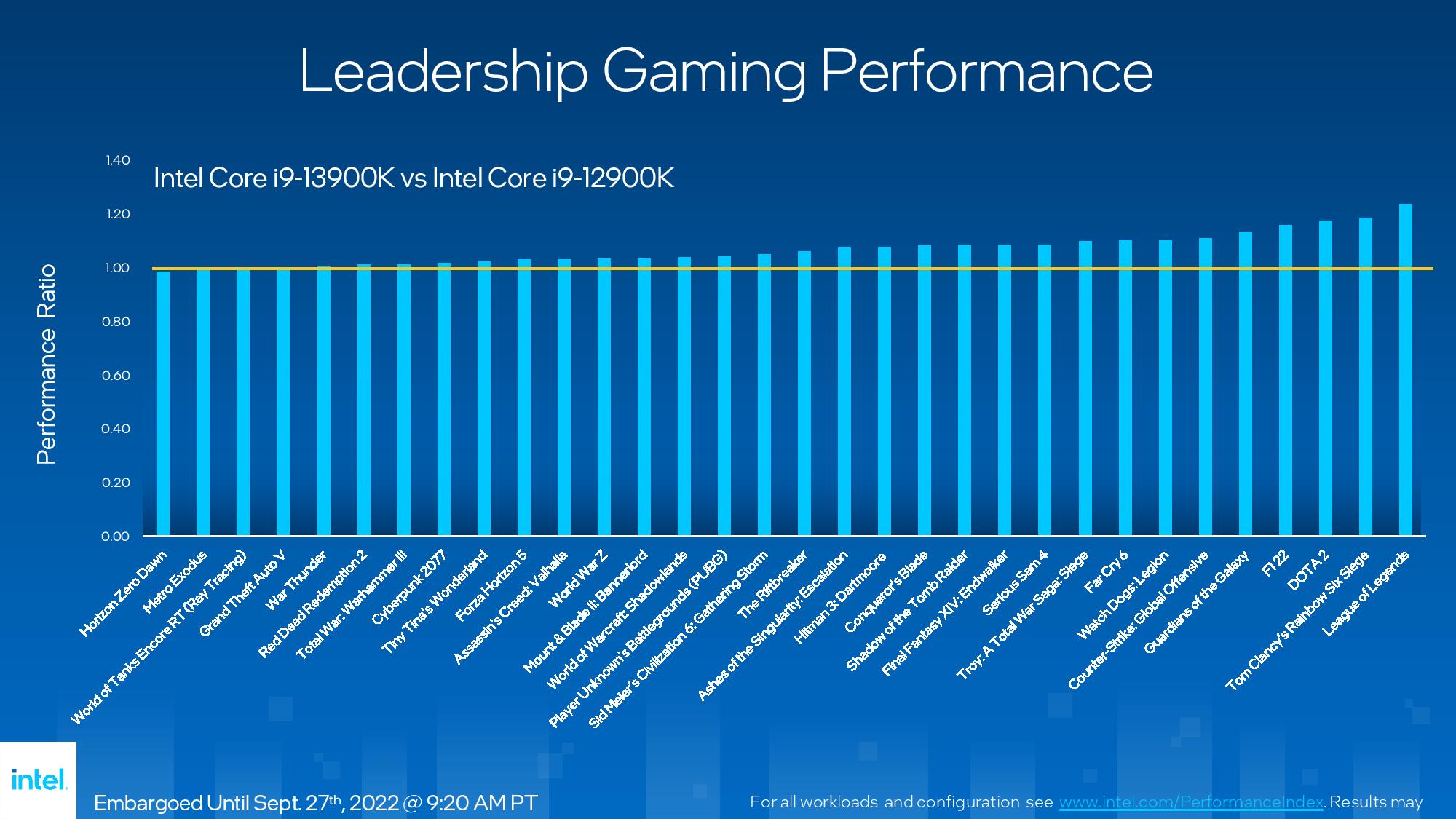
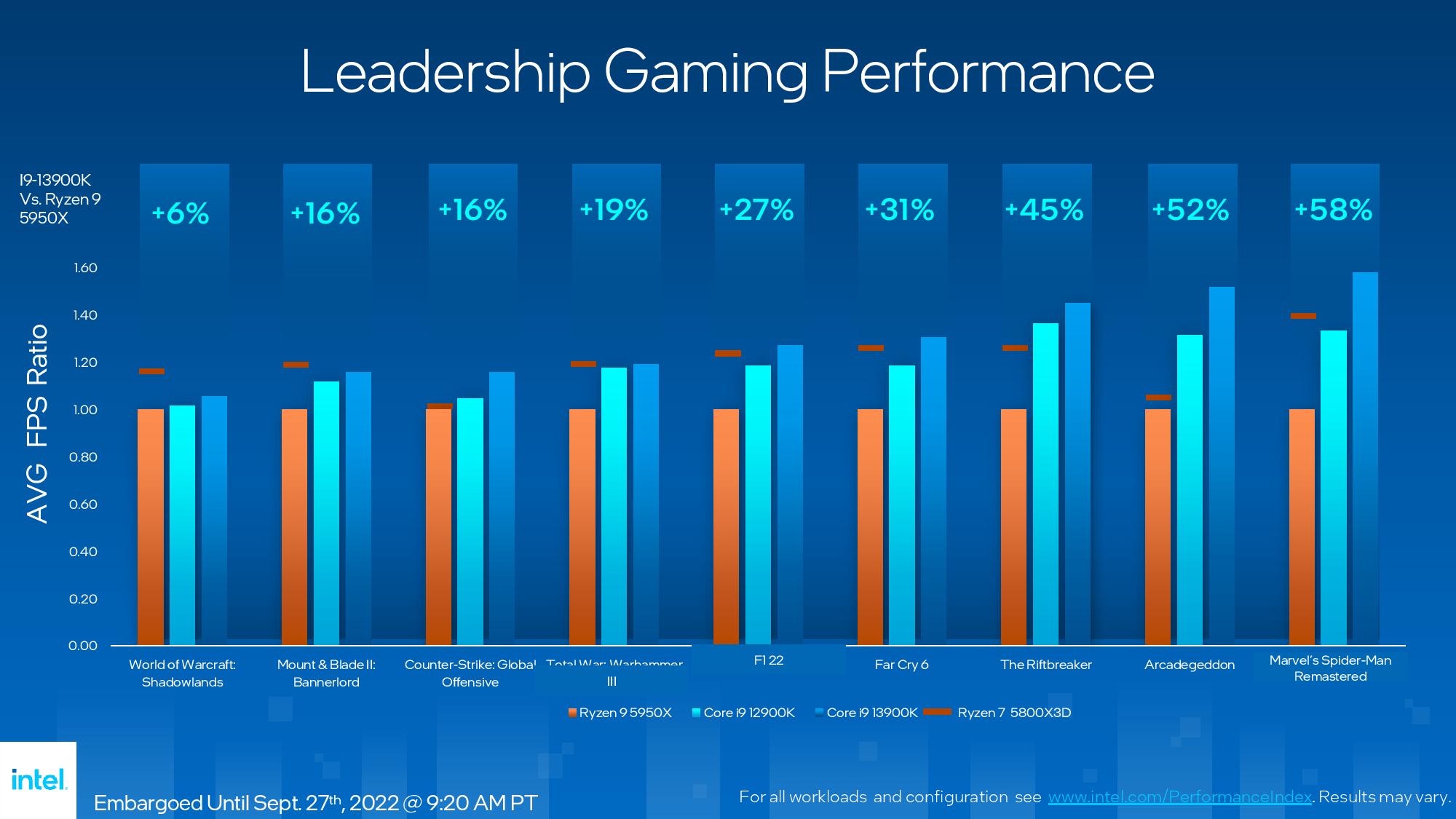
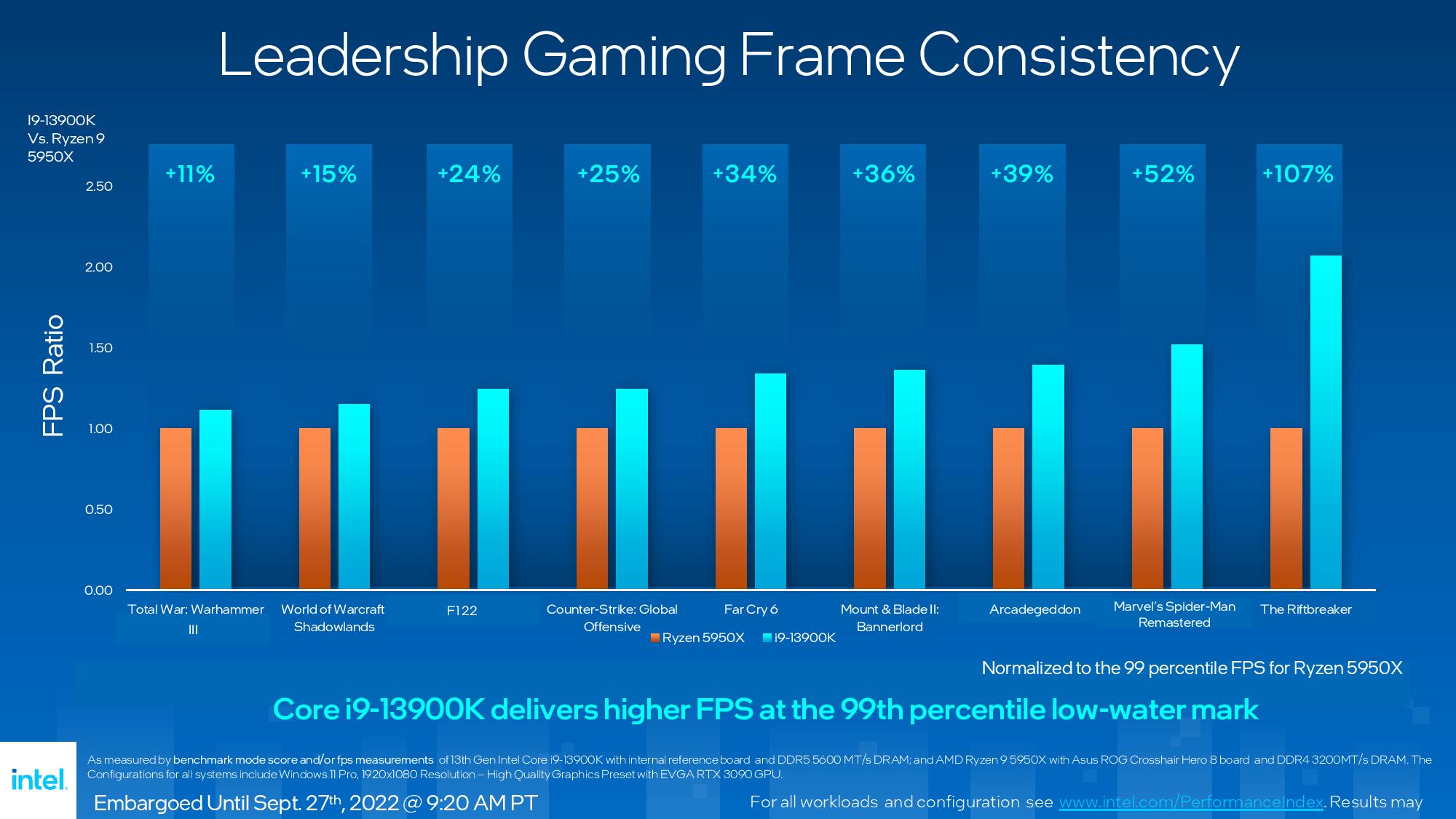
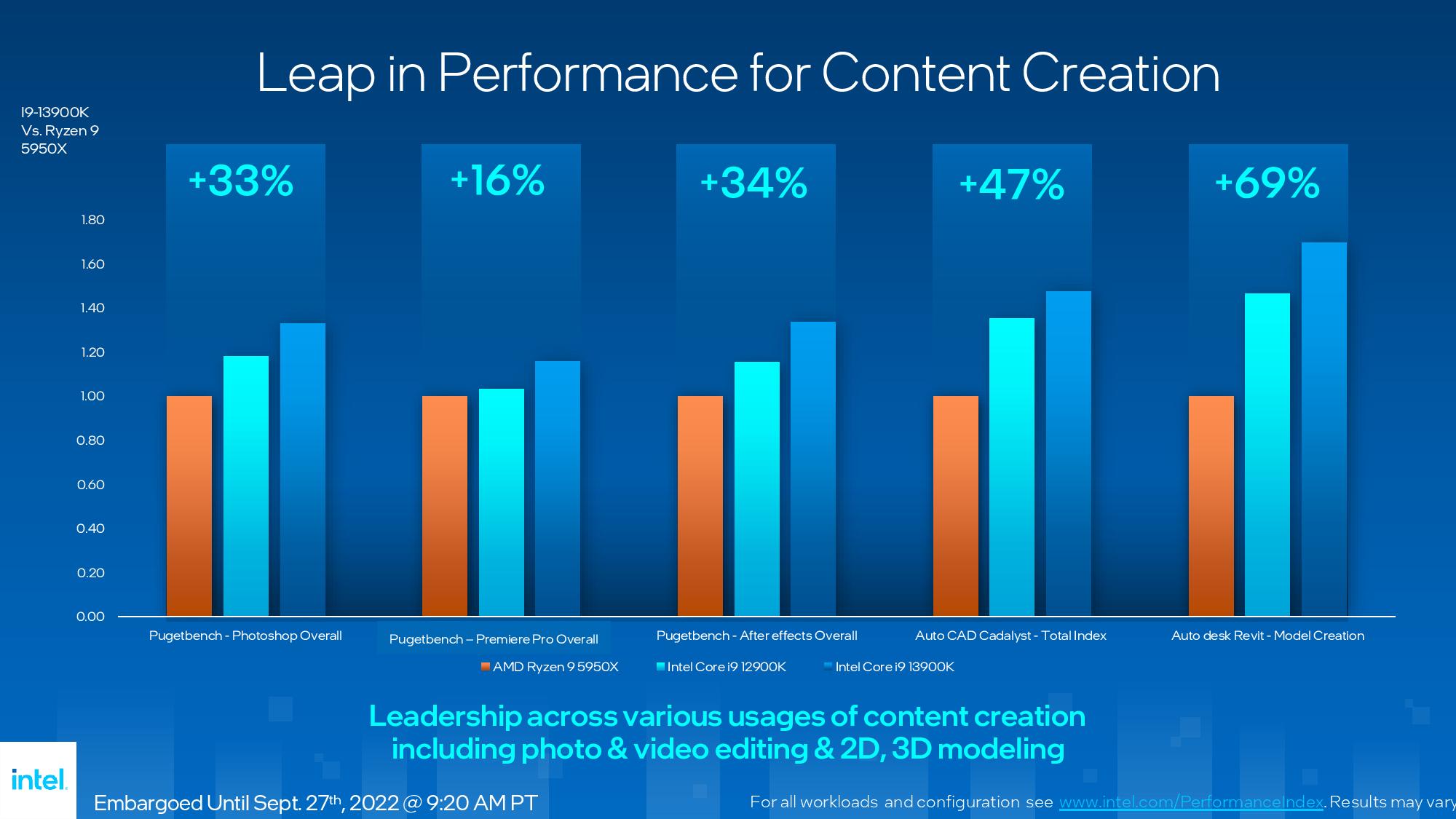
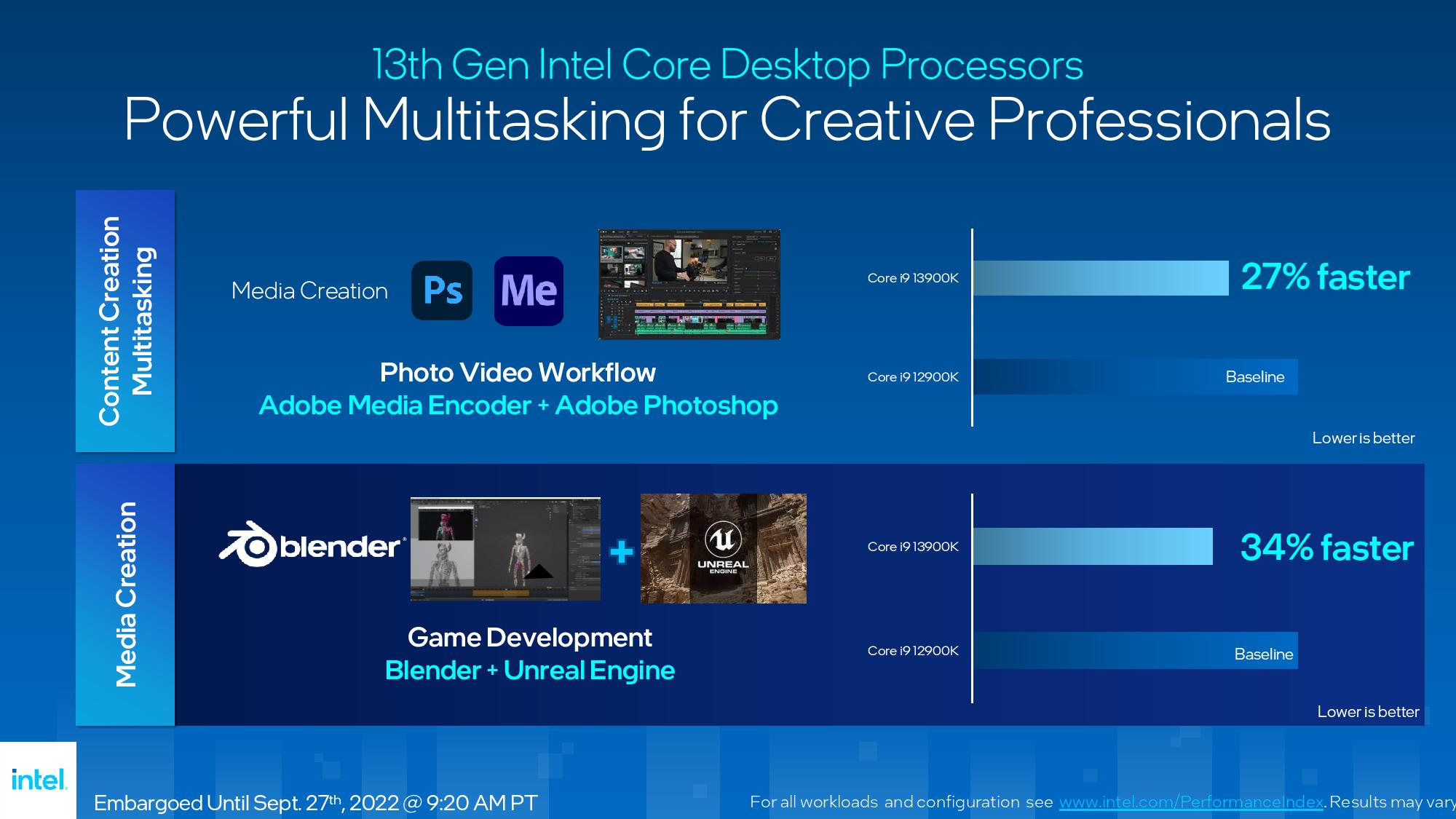
Intel claims that the Core i9-13900K is 5% faster than the 12900K in more than half of the 32 games it tested, and up to 25% faster in some. In our testing, AMD's recently released Ryzen 9 7950X is roughly 5% faster in gaming than Intel's Core i9-12900K. Given that Intel claims most titles will land at 5% faster than the 12900K or above, we will surely see a very close race between the chipmakers.
Intel also shared projections against AMD's now previous-gen Ryzen 5000 chips, but the company didn't have access to the new Ryzen 7000 for testing. The percentages at the top of the second slide are versus AMD's Ryzen 9 5950X, but you'll notice that the Ryzen 7 5800X3D is only represented as a thin line above the 5950X bar on the chart.
The exotic and pricey 5800X3D is currently the fastest gaming chip on the market, courtesy of its 3D V-Cache tech. Still, you do have to remember that the 5800X3D doesn't accelerate all games and comes with severe tradeoffs in application performance compared to similarly-priced chips. It appears that Raptor Lake will beat the 5800X3D in some titles, but it won't be able to unseat the 5800X3D from the title of being the fastest for gaming overall. That's not totally unexpected -- even AMD's new Ryzen 7000 can't beat its previous-gen chip.
Intel has added 99th percentile framerates to its marketing repertoire, a first. As a reminder, 99th percentile framerates are popular in CPU and GPU reviews because they're a good indicator of the smoothness of a game. As you'd expect, Intel claims a lead here over the Ryzen 9 5950X. You'll notice the company didn't include the 5800X3D in this slide.
Intel also included a few content creation benchmarks, showing big speedups over its previous-gen chips and the Ryzen 9 5950X. The new Ryzen 9 7950X is incredibly powerful in content creation apps, but it looks like we'll see another tight race when the 13900K arrives.
The best leaked benchmarks come from both a review of Rocket Lake Core i9-13900K submissions to the SiSoftware Sandra database and also a video review posted in China that you can watch here. For non-Chinese speakers, we have the rundown of those tests below:
| Benchmark | Core i9-13900K | Core i9-12900KF | Percent Change |
| CPU-Z bench 1T | 892.2 | 815.5 | +9.4% |
| CPU-Z bench nT | 16,606 | 11,348 | +46.3% |
| Geekbench 1T | 2,133 | 1,939 | +10% |
| Geekbench nT | 23,701 | 19,304 | +22.8% |
| Cinebench R23 1T | 2,206 | 1,940 | +13.7% |
| Cinebench R23 nT | 37,385 | 26,939 | +38.8% |
| 3D Mark Timespy CPU | 23,839 | 20,121 | +18.5% |
| PugetBench Premiere Pro | 1,213 | 1,003 | +20.1% |
The tested 13900K is a Qualification Sample (QS), meaning it is nearly identical to the retail models. The 13900K had a 3 GHz base and 5.8 GHz boost for the P-cores and was tested on a ROG Maximus Z690 Extreme, but without optimized firmware. The chip was dialed into the correct 125W/250W power range for the tests.
On average, across a broad variety of tests, the 13900K was 10% faster in single-thread and 35% faster in multi-threaded workloads than the previous-gen 12900K. That's quite an impressive multi-threaded gain given that it stems almost entirely from the extra eight E-Cores and cache. The tests expose even higher gains in some of the individual threaded benchmarks, like CPU-z and Cinebench, which registered a whopping 46% and 40% improvement, respectively. The outlet later added power measurements with the correct power settings, showing a more realistic power draw of 253W. That resulted in the chip running at 77C during an extended test.
| Row 0 - Cell 0 | Core i9-13900K | Core i9-12900K | AMD 5950X |
| Cores / Threads | 24C/32T | 16C/24T | 16C/32T |
| 1T score | 2,133 | 1,987 | 1,686 |
| Multi-thread score | 23,701 | 17,272 | 16,508 |
Above, we can see the results from a different Geekbench 5 test submission that showed the Core i9-13900K, which was paired with 32GB of DDR4-6400 memory, boosting to 5.7 GHz. This test showed the 13900K as being 7% faster in single-thread and 37% faster in multi-threaded tests than the previous-gen 12900K. More importantly, it was 26% faster in single-and 43% faster in multi-thread than the Ryzen 9 5950X. Geekbench later removed this result from its database due to a timing error during the benchmark run, so it might not represent the actual performance or boost clock speeds. Given the test results we saw in the full review we shared above, this appears to be close to accurate.
We've also seen the Raptor Lake Core i9-12900K take the lead in Passmark's overall ranking of single-threaded performance, beating all other chips that have been tested in the benchmark. New Raptor Lake benchmarks have also surfaced for the non-K Raptor Lake Core i3-13100, Core i5-13400, and Core i9-13900.
| Row 0 - Cell 0 | Core i5-13600K | Core i5-12600K | Core i9-12900K | Ryzen 9 5950X |
| CPU-Z 1T | 830 | 753 | 803 | 684 |
| CPU-Z nT | 10,032 | 6,692 | 10,921 | 12,078 |
| CB23 | 1,387 | 1,886 | 1,965 | 1,652 |
| CB23 nT | 24,420 | 17,161 | 27,287 | 26,271 |
The Core i5-13600K has purportedly been tested by a known leaker with access to early hardware. These results point to an exceptional amount of performance gains from the extra four e-cores over the previous-gen Core i5. The Core i5-13600K is 8% and 44% faster in the CPU-z single- and multi-threaded tests, respectively, than the previous-gen i5-12600K.
Additionally, the chip beat the Ryzen 9 5950X in both single- and multi-threaded CPU-z benchmarks, and only lagged ~7% in the Cinbench threaded benchmark. A subsequent listing in the GeekBench database was just as impressive, showing similar gains. Bearing in mind that the Core i5 will retail for around $300 and the 5950X retails for over $500, these results are impressive. Overall, the Core i5-13600K is in the range of the current-gen Core i7 in these tests.
We've also recently seen a direct Core i9-13900K vs Ryzen 9 7950X showdown in Blender, with the 7950X taking a 9% lead.
Intel 13th-Gen Raptor Lake Architecture
Intel's Raptor Lake comes with 'Raptor Cove' p-cores, while the E-Cores stick with Gracemont. Both cores do have significantly more L2 cache, suggesting a re-working of the underlying designs. The Raptor Lake chip will also now share up to 36 MB of L3 cache, representing an increase of 6MB over the previous generation. However, this simply represents the addition of two more 3MB L3 cache clusters and not an increase in per-core cache capacity.
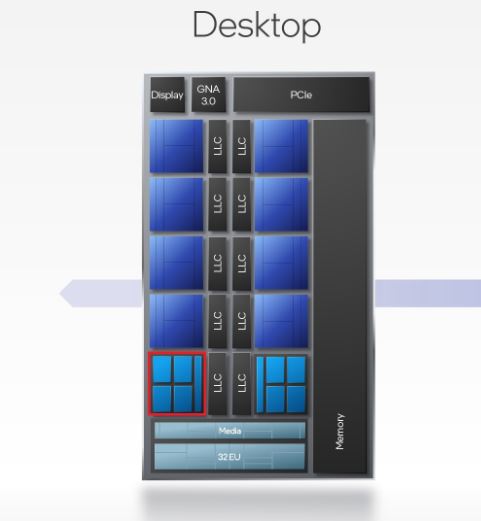
As you can see in the image of the Alder Lake die above, the hybrid architecture pairs a 3MB slice of L3 cache (labeled as LLC) next to each 'block' of cores. The P-cores, in dark blue, each have an L3 slice nearby, while the E-cores, in light blue, come in quad-core clusters that also have a 3MB slice of L3 cache nearby. These slices of cache are shared among all cores.
The new Raptor Lake 8+ 16 die (covered in the previous section) comes with 16 E-Cores. Those additional E-Cores would equate to the above Alder Lake die being stretched to accommodate two more light blue quad-core clusters of E-Cores. Those two clusters would come with two more 3MB L3 cache slices, bringing the total capacity to the 36MB we see with the Core i9-13900K.
Interestingly, Alder Lake's cache scheme introduced a new way for Intel to disable cache for lower core count SKUs. In the past, to create lower-end SKUs with fewer cores, Intel disabled entire slices of L3 cache (the LLC blocks in the image) in lockstep with any cores it disabled. With Alder Lake, Intel transitioned to not disabling any entire slice of L3, instead merely disabling some banks in each slice, thus reducing per-slice capacity (from 3MB to 2MB, for instance). This makes plenty of sense as it keeps stops on the ring bus active, and it also allows for creating SKUs with higher cache capacity than we would typically expect based on the number of disabled cores.
Intel has increased per-core L2 cache capacity for both the P-Cores and the E-Cores. The E-Cores see an increase to 2MB of private L2 cache per core, a 60% increase over the 1.25 MB per core found in Alder Lake. Intel also boosted the amount of L2 cache shared among each quad-core cluster of E-Cores to 4 MB, a doubling over the 2MB with Alder Lake. That means we'll see up to 32MB of L2 cache. As we've seen with Intel's previous chips that got a big increase in L2 capacity, this type of improvement tends to result in better performance in multi-threaded workloads, but it is possible that it could result in higher IPC in some workloads due to keeping the cores fed with more data. It should also help free the ring from some traffic that would otherwise be present for shuffling around L3 data, thus allowing greater scalability.
Intel's larger 4MB L2 cache on the e-core clusters also employs a new dynamic prefetching algorithm that uses real-time telemetry data and machine learning to dynamically adjust the prefetch algorithm based on the type of workload it is executing. Intel says this helps improve performance in some types of applications by ~2%, like Adobe Photoshop, After Effects, and Lightroom, and in an unspecified application by up to 16%.
Intel also employs a different dynamic 'Inclusive/non-inclusive' (INI) approach for its L3 cache, but this adjusts between inclusive and non-inclusive caching schemes on the fly. Caches are typically hard-coded to run with either of these policies and can't be changed. As a reminder, inclusive caching keeps a copy of L2 data in the L3 cache and typically improves performance in single-threaded work by providing a faster hit rate for serial workloads, while non-inclusive caching only keeps part of the L2 cache in L3 to improve performance in threaded workloads. Intel's INI uses machine learning and real-time telemetry to make changes to this policy on the fly, thus providing the best of both worlds.
The L1 cache for both types of cores remains the same (L1i$ 32kB, L1D$ 48Kb for P-Cores — L1i$ 64kB, L2D$ 32kB for E-Cores).
We spoke with Intel Fellow and Chief CPU Architect, Adi Yoaz, at Intel's Israel event about the new scheme, and he tells us that this approach is the result of the microcontroller that Intel originally designed into each Alder Lake core, but hasn't yet fully used. New firmware updates to this microcontroller employ machine learning algorithms that better analyze telemetry data to make adjustments to the caching scheme at a 200-microsecond granularity. We'll share more details about this tech in our review.
Speaking of telemetry, Intel's Thread Director, which steers threads to the right type of core (p- or e-core) based on the type of workload, gets a significant overhaul in the Windows 11 22H2 update. Intel has updated the workload classification engine with machine learning algorithms and also improved the handling of foreground and background tasks.
Raptor Lake's E-Cores still do not support AVX-512, so Intel will keep the feature disabled, which is odd given that AMD's Ryzen 7000 supports the extensions. As before, AVX2 and VNNI remain enabled for the E-Cores.
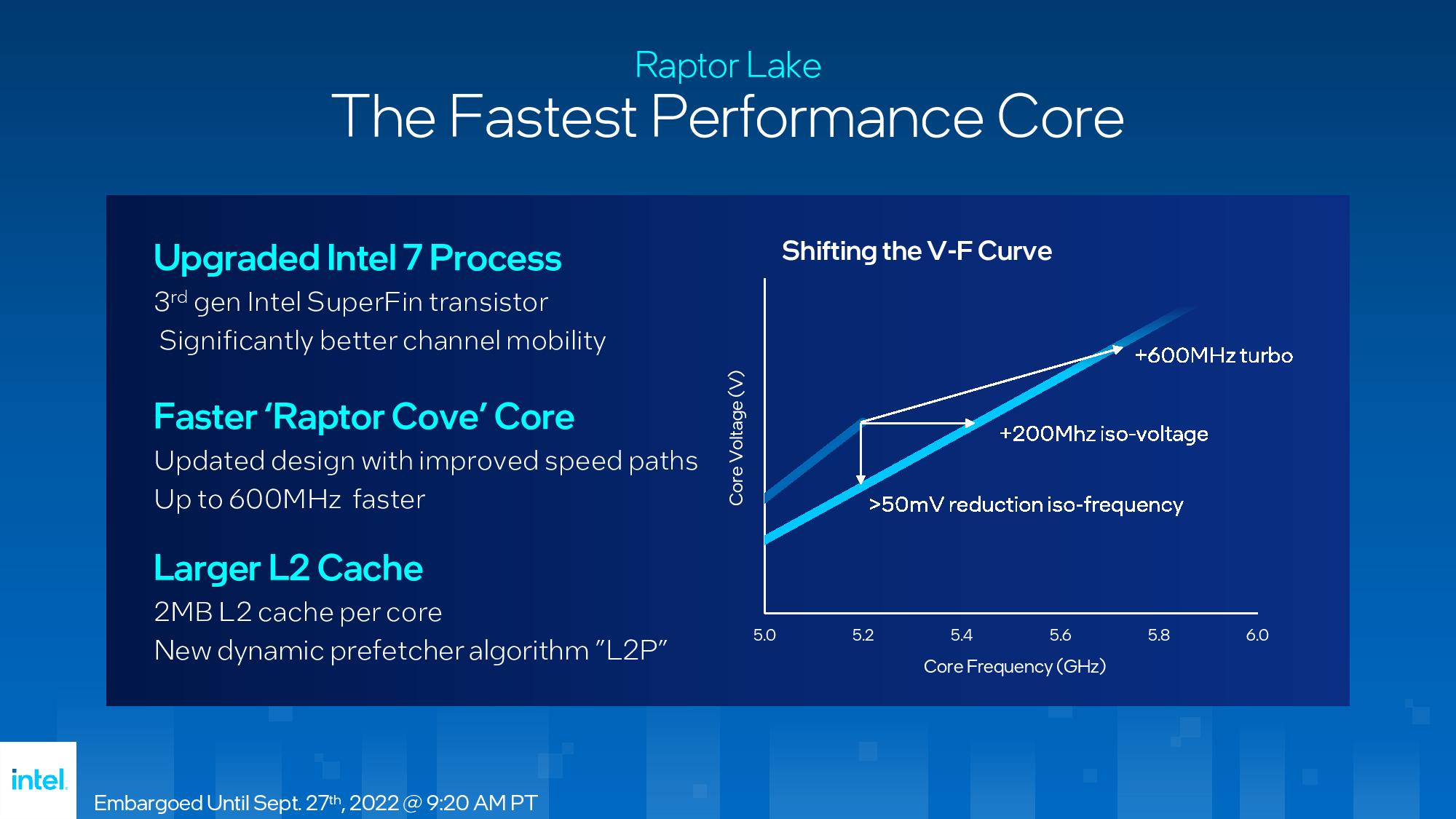
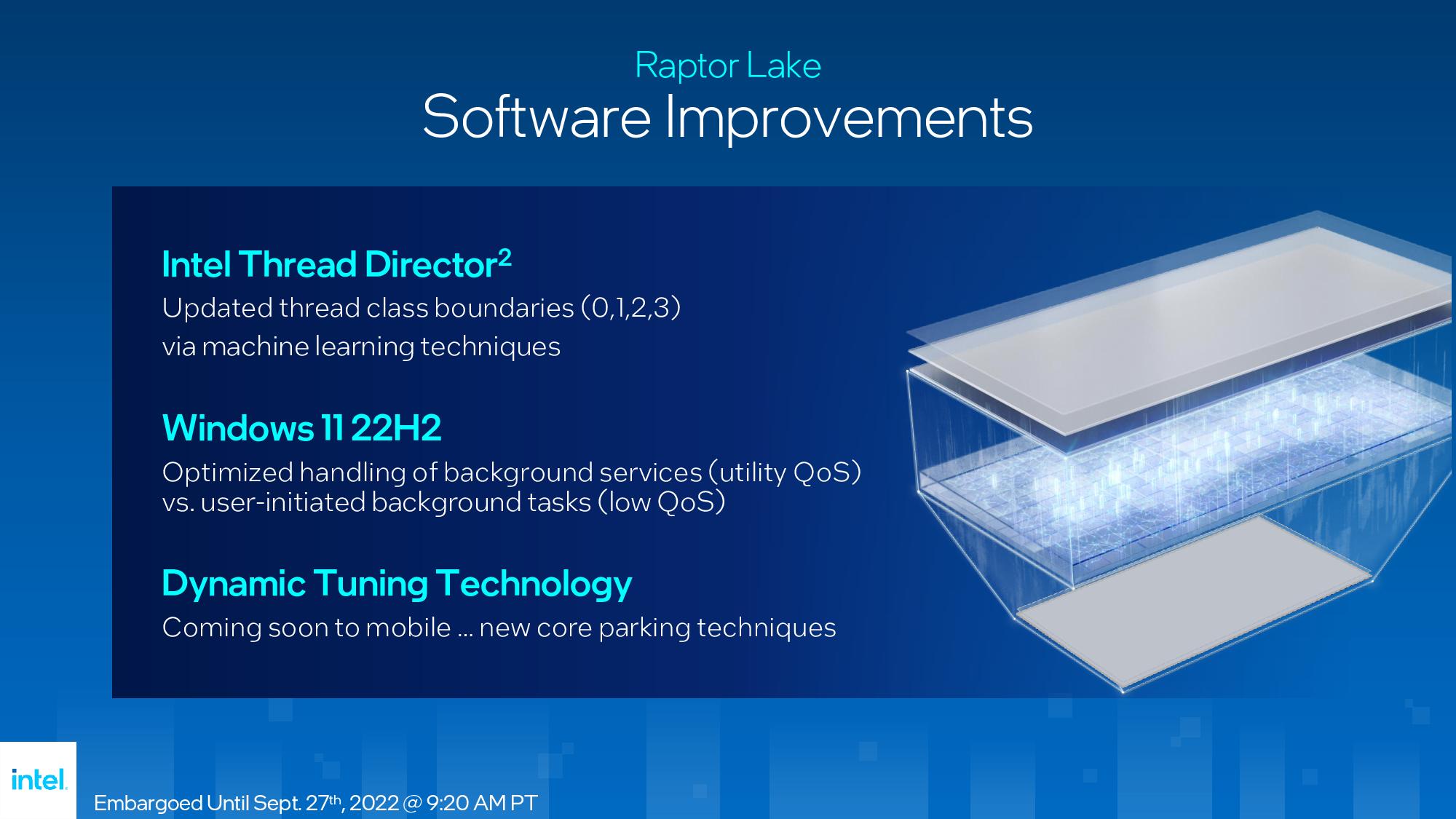
Intel significantly improved its 'Intel 7' process node by employing faster third-gen SuperFin transistors and increasing the channel mobility (Intel declined to provide more specifics on the latter). Intel claims this yielded what would typically be considered a full node's worth of performance improvement. As you can see above, this allowed Intel to 'shift and extend' the voltage/frequency curve to deliver better performance at both high and low voltages (>50mV reduction at the same frequency, or a 200 MHz increase at the same voltage).
We'll soon see a 6 GHz Raptor Lake model because the improved node characteristics paired with improved speed paths within the design (likely using leakier, faster transistors in key paths) allowed Intel to dial up the peak clock rates by 600 MHz. Intel says that Raptor Cove is the fastest core it's ever built, but that the Raptor Lake mobile chips will be tuned more for the lower-power end of the V/F curve to improve efficiency.
Leveraging the faster memory speeds requires a faster fabric. Intel has increased the ring bus frequency to 5 GHz and it is 900 MHz faster during all-core turbo, addressing a glaring issue we saw with Alder Lake. Intel says the ring bus enhancements alone can result in 5% higher framerates (we've also seen solid increases from overclocking this setting on Alder Lake).
Intel 13th-Gen Raptor Lake 700-Series Motherboards, Z790, H770, B760, H610
The Raptor Lake chips will use the same LGA1700 socket as Alder Lake, meaning they have the same socket and pinout, and both Raptor and Alder will be compatible with both the 600- and 700-series motherboards, providing quite a bit of flexibility for both generations. However, if you use a Raptor Lake chip on a 600-series motherboard, you'll lose the improvements in PCH PCIe lane configurations that we'll outline below. We've already seen a plethora of Z790 motherboard listings emerge, with even DDR4-compatible Z790 motherboards coming from the likes of Asus and MSI, but details for those specific models are still slight.
All LGA1700 coolers are compatible, so you won't need a new CPU cooler for Raptor Lake. Naturally, existing 600-series boards will require a BIOS update to support Raptor Lake, and several motherboard manufacturers, like Asus and ASRock, have already released the updates.
Raptor Lake brings a significant number of big steps forward in connectivity. The previous-gen Alder Lake chips support 16 PCIe 5.0 lanes for a discrete GPU and four PCIe 4.0 lanes from the CPU for an M.2 SSD.
| PCH Connectivity (up to) | 700-series (Raptor Lake) | 600-series (Alder Lake) |
| PCIe 4.0 | 20 | 12 |
| PCIe 3.0 | 8 | 16 |
| USB 3.2 Gen 2x2 (20G) | 5 | 4 |
Intel itself leaked the 700-series chipset changes. The x8 DMI 4.0 connection between the CPU and the chipset (PCH) remains present, but the chipset also has improvements. In the past, the PCH supported up to 16 PCIe 3.0 lanes and up to 12 PCIe 4.0 lanes, but Intel has increased the number of PCIe 4.0 lanes to 20 and reduced the number of PCIe 3.0 lanes to eight, thus expanding connectivity. Intel also increased the number of USB 3.2 Gen 2x2 (20G) connections from a peak of four to five.
All other PCH connectivity options found with the Alder Lake motherboards remain unchanged with the Raptor Lake chipset itself. However, we will see somewhat different allocations with the Z790, H770, and B760 motherboards based on the new features. You can see Intel's accidentally-released breakdown, which we've independently confirmed, above. The highlighted regions list the changes (Z690 = Z790, H670 = H770, B660 = B760).
Intel Raptor Lake Thread Director
Alder Lake pioneered the hybrid era for x86 desktop PCs, and Intel's Thread Director, which ensures that threads are placed on the correct cores, is the magic that glues the design together. Raptor Lake will come with improvements to the Thread Director technology, a result of what Intel says is an upgradeable and tunable design that will improve over time. Intel's Thread Director gets a significant overhaul in the Windows 11 22H2 update. Intel has updated the workload classification engine with machine learning algorithms and also improved the handling of foreground and background tasks.
Just like we saw with Alder, Raptor Lake will use both faster and slower cores that are optimized for different voltage/frequency profiles. As such, unlocking the maximum performance and efficiency requires the operating system and applications to have an awareness of the chip topology to ensure workloads (threads) land in the correct core based on the type of application.
That's where Intel's Thread Director technology comes in. This hardware-based technology provides enhanced telemetry data to Windows 11 to assure that threads are scheduled to either the P or E cores in an optimized and intelligent manner, but in a way that's transparent to software.
This technology works by feeding the Windows 11 operating system with low-level telemetry data collected from within the processor itself, thus informing the scheduler about the state of the core, be it power, thermal, or otherwise. Alder Lake chips will also work fine with a bog-standard Windows 10 operating system – existing thread-scheduling techniques continue to work with the processors, just not as well. While the chips work, you'll miss out on the enhanced capabilities of Thread Director (that's Windows 11 only), which will have a varying impact on performance and power consumption based on instruction type and application usage models. In other words, your mileage will vary.
Intel 13th-Gen Raptor Lake Pricing
| Row 0 - Cell 0 | Price | Cores / Threads (P+E) | P-Core Base / Boost Clock (GHz) | E-Core Base / Boost Clock (GHz) |
| Core i9-13900K / KF | $589 (K) - $564 (KF) | 24 / 32 (8+16) | 3.0 / 5.8 | 2.2 / 4.3 |
| Ryzen 9 7950X | $699 | 16 / 32 | 4.5 / 5.7 | - |
| Core i9-12900K / KF | $589 (K) - $564 (KF) | 16 / 24 (8+8) | 3.2 / 5.2 | 2.4 / 3.9 |
| Ryzen 9 7900X | $549 | 12 / 24 | 4.7 / 5.6 | - |
| Core i7-13700K / KF | $409 (K) - $384 (KF) | 16 / 24 (8+8) | 3.4 / 5.4 | 2.5 / 4.2 |
| Core i7-12700K / KF | $409 (K) - $384 (KF) | 12 / 20 (8+4) | 3.6 / 5.0 | 2.7 / 3.8 |
| Ryzen 7 7700X | $399 | 8 / 16 | 4.5 / 5.4 | - |
| Ryzen 5 7600X | $299 | 6 / 12 | 4.7 / 5.3 | - |
| Core i5-13600K / KF | $319 (K) - $294 (KF) | 14 / 20 (6+8) | 3.5 / 5.1 | 2.6 / 3.9 |
| Core i5-12600K / KF | $289 (K) - $264 (KF) | 10 / 16 (6+4) | 3.7 / 4.9 | 2.8 / 3.6 |
Intel has already taken a no-holds-barred bare-knuckle approach to pricing with Alder Lake as it attempts to steal back market share from AMD, and that approach continues for Core i7 and Core i9. For instance, the 13900K undercuts AMD's Ryzen 9 7950X by $100, but should offer very similar, if not faster, levels of performance.
However, Intel did recently announce that it would increase pricing due to the increased cost of materials, supply chain disruptions, and inflation, and we do see the impact in Core i5. While the company left its Core i9 and i7 pricing the same as we saw with the previous gen, it raised pricing for the Core K-series by $30. Both the full-fledged model and the graphics-less 13600KF are $30 more expensive than the prior gen. This is by far the highest-volume SKU and slots into a pricing tier where AMD isn't as competitive, so Intel's increase here will generate the most cash while not threatening its strategy of undercutting AMD on the high end. However, AMD's $299 Ryzen 5 7600X is a potent gaming chip, so we'll have to see how the performance story plays out when Raptor Lake hits our bench table.
AMD has announced pricing for its Ryzen 7000 processors, and aside from shaving $100 off of its flagship 16-core Ryzen 9 7950X, it remains mostly similar to the previous-gen models. AMD has a high $299 bar for entry to its newest family of chips, showing that the company will continue to prioritize selling its priciest high-margin silicon.
In the end, a lot of the difference in pricing between Intel's Raptor Lake and AMD's Ryzen 7000 will boil down to platform costs. We can expect some of the same trends that we saw with Alder Lake motherboards: DDR5-supporting boards will carry a premium over their DDR4 counterparts due to the more expensive manufacturing techniques and materials required to support the faster interface. However, the option for DDR4 motherboards will be a significant advantage over competing Ryzen 7000 platforms, which are DDR5-only. We do expect DDR5 pricing to recede significantly by the time both of these platforms are on the market, but the jury is still out on DDR5 pricing.
AMD's AM5 motherboard product stack will include provisions for PCIe 4.0-only motherboards, another way to save on cost, while Intel's lineup won't have that option. That will provide two tiers of motherboard pricing for AMD, too, but costs will be adjusted on a different axis. It will certainly be interesting to see which approach offers the biggest pricing deltas between the full-fledged implementations.
In the end, all pricing analysis has to be informed by performance, and we only have half the picture. You can see how the Ryzen 9 7950X and Ryzen 5 7600X perform in those reviews, and we'll soon have the 13th-Gen Intel Raptor Lake processors in our test labs for comparison to give us the other half of the picture.
- MORE: Zen 4 Ryzen 7000 All We Know
- MORE: AMD vs Intel
- MORE: How to Overclock a CPU
- MORE: How to check CPU Temperature

Paul Alcorn is the Editor-in-Chief for Tom's Hardware US. He also writes news and reviews on CPUs, storage, and enterprise hardware.
-
-Fran- I think there's a typo/error in the PCIe lanes for the chipsets table where you state: "In the past, the PCH supported up to 16 PCIe 3.0 lanes and up to 12 PCIe 4.0 lanes, but Intel has increased the number of PCIe 4.0 lanes to 20 and reduced the number of PCIe 3.0 lanes to eight", as the table reflect the reverse and had me scratching my head for a bit xDReply
Regards. -
thisisaname ReplyEven though Raptor Lake is clearly on the cusp of coming to market this year — we've even seen chips sold at auction and benchmarks in the wild — Intel has been uncharacteristically silent about its pending line of chips for desktop PCs.
Sounds to me they are playing a high tech version of Chicken with AMD to see who will blink first and release some real data about their chips. -
SiliconFly Dear Tom's Hardware,Reply
You have used the word "Rocket Lake" instead of "Raptor Lake" in 11 places in the article. Esp. in the section titles. Kindly fix it as it's a bit misleading.
-SiFy. -
jp7189 I think you should have used a WDC Raptor X . That was a unique and very cool drive. I keep one in a drawer so I can one day show grandkids how a hard drive worked. Lol.Reply -
jp7189 Reply
(In the background of the top pic)jp7189 said:I think you should have used a WDC Raptor X . That was a unique and very cool drive. I keep one in a drawer so I can one day show grandkids how a hard drive worked. Lol. -
shady28 A lot of benchmarks show DDR5-6000+ is where DDR5 starts to overtake DDR4 so we may start to see some sizeable performance increases if Intel can get it certified for DDR5-5600, which hopefully will also translate into higher success rates with OC DDR5. DDR5-6200 seems pretty affordable now as well.Reply
I also like the increased push away from the old USB 3 5Gbps standards. I think these new 7XX motherboards will be more expensive because of that, but that's ok by me if they have better connectivity and IO. IO throughput is one of those areas most sites don't test anymore, but there are big differences between different motherboards in this area (m.2 and USB throughputs can vary wildly).
I don't expect raw performance on most tasks to go up on RL though. 5% maybe on single thread, possibly 15% if you factor in higher clocks, while multi-thread is IMO highly overrated and is more of a benchmark competition than being relevant to most users. -
PCWarrior Well we typically see ES leaks about upcoming cpus first show up around 6-9 months prior to release and these leaks get more frequent and accurate as time goes by. When the launch date is only 2-3 months away we see multiple leaks about performance and specs and a 1 month earlier we even get pricing information. We even see ES out in the wild being sold 1-3 months prior to launch. To me it is certain that Raptor lake will be launching at most 3 months from now – that is early October. The announcement (and sending samples to the tech press for reviewing) should come in mid/late September.Reply
The same applies to AMD and what worries me is that despite AMD cpus being officially stated to launch in fall 2022 and despite being supposedly expected to launch even earlier than Raptor lake, in September, we don’t have any real leaks unlike Raptor lake. This indicates at the very least a very small (or no) volume of cpus circulating outside AMD labs for testing and the last time this happened, with the 3D-Vcache cpus, it meant a delay. Everyone was talking and expecting these cpus to come somewhere in October-December 2021. But we were getting absolutely no leaks. It turned out they weren’t ready and came out much later (April 2022) and it was just a single SKU. My hunch is that AMD will only be announcing, demonstrating and paper launching their cpus in late September and real availability/launch will come significantly later (in early/mid November or so).
These two generations should be trading blows on multiple fronts. Intel's single/light threaded and per core performance of the p-cores should see a 10-15% increase (combined IPC and frequency gains). Purely multithreaded should increase by 30-45% depending on the application. AMD will see a 25-30% increase in single/light threaded (not enough to match Intel which is already 15-30% ahead with Alderlake) and 30% increase in purely multithreaded (depending on the application the 5950X is already trading blows with the 12900K and a 30% increase will keep AMD in close range to Raptor lake but still likely lose overall). -
shady28 ReplyPCWarrior said:Well we typically see ES leaks about upcoming cpus first show up around 6-9 months prior to release and these leaks get more frequent and accurate as time goes by. When the launch date is only 2-3 months away we see multiple leaks about performance and specs and a 1 month earlier we even get pricing information. We even see ES out in the wild being sold 1-3 months prior to launch. To me it is certain that Raptor lake will be launching at most 3 months from now – that is early October. The announcement (and sending samples to the tech press for reviewing) should come in mid/late September.
The same applies to AMD and what worries me is that despite AMD cpus being officially stated to launch in fall 2022 and despite being supposedly expected to launch even earlier than Raptor lake, in September, we don’t have any real leaks unlike Raptor lake. This indicates at the very least a very small (or no) volume of cpus circulating outside AMD labs for testing and the last time this happened, with the 3D-Vcache cpus, it meant a delay. Everyone was talking and expecting these cpus to come somewhere in October-December 2021. But we were getting absolutely no leaks. It turned out they weren’t ready and came out much later (April 2022) and it was just a single SKU. My hunch is that AMD will only be announcing, demonstrating and paper launching their cpus in late September and real availability/launch will come significantly later (in early/mid November or so).
These two generations should be trading blows on multiple fronts. Intel's single/light threaded and per core performance of the p-cores should see a 10-15% increase (combined IPC and frequency gains). Purely multithreaded should increase by 30-45% depending on the application. AMD will see a 25-30% increase in single/light threaded (not enough to match Intel which is already 15-30% ahead with Alderlake) and 30% increase in purely multithreaded (depending on the application the 5950X is already trading blows with the 12900K and a 30% increase will keep AMD in close range to Raptor lake but still likely lose overall).
I expect Zen 4 launch to be much like Zen 3. It wasn't reported on very much, but AMD only produced approximately 1 million Zen 3 in 2020 Q4 with an October "Launch". Moreover, that number is 'charitable' with some unlikely assumptions.
According to this article the number of x86 CPUs shipped in 2021 was 471 Million. Assuming 2020 was similar, AMD was able to supply something like zero point five (0.5) percent of the Q4 market with Zen 3, and only on enthusiast grade desktop. This is the textbook definition of a paper launch. It wasn't until March / April of 2021 that Zen 3 desktop was at least somewhat available albeit at inflated prices, and by then we had Rocket Lake aplenty and Tiger Lake was actually progressing beyond the original low power SKU launch to the higher power H series.
The issue here is that AMD has limited, pre-scheduled production from TSMC. Given that, they will allocate that production first to that required by contract (PS5, XBox) and then to the most profitable SKUs, the rest get leftovers.
The most profitable SKUs are going to be EPYC, and they still have a ton of demand from consoles.
So based on those facts, I would not expect Zen 4 to be a real obtainable product for 99% of the people until 2023. With Intel, you can count on being able to fairly easily obtain their product 4-6 weeks after launch, and if you really want it you can probably get it for a premium in the first couple of weeks.
